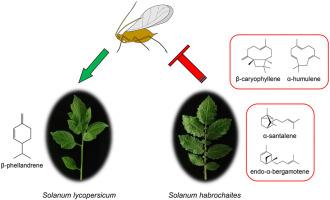当前位置:
X-MOL 学术
›
Phytochemistry
›
论文详情
Our official English website, www.x-mol.net, welcomes your
feedback! (Note: you will need to create a separate account there.)
Glandular trichome-derived sesquiterpenes of wild tomato accessions (Solanum habrochaites) affect aphid performance and feeding behavior
Phytochemistry ( IF 3.2 ) Pub Date : 2020-12-01 , DOI: 10.1016/j.phytochem.2020.112532 Fumin Wang , Yong-Lak Park , Michael Gutensohn
Phytochemistry ( IF 3.2 ) Pub Date : 2020-12-01 , DOI: 10.1016/j.phytochem.2020.112532 Fumin Wang , Yong-Lak Park , Michael Gutensohn

|
Glandular trichomes of tomato produce a number of secondary metabolites including terpenes that contribute to host plant resistance against pests. While glandular trichomes of cultivated tomato Solanum lycopersicum primarily accumulate a monoterpene blend, those of wild tomato species like Solanum habrochaites produce various sesquiterpenes. Previous studies have shown that glandular trichome derived terpenes in cultivated and wild tomato species have repellent and toxic activity against multiple biting-chewing herbivores. In contrast, considerably less is known about the effect of these glandular trichome derived terpenes on piercing-sucking herbivores such as aphids. Here, we have screened a collection of S. habrochaites accessions representing five chemotypes that produce distinct sets of sesquiterpenes to identify those affecting the potato aphid (Macrosiphum euphorbiae). Non-choice assays demonstrated that the longevity and fecundity of M. euphorbiae was significantly reduced when kept on the leaf surface of S. habrochaites accessions producing β-caryophyllene and α-humulene, or α-santalene, α-bergamotene, and β-bergamotene, respectively. When M. euphorbiae apterae were feeding on artificial diets with added terpene containing leaf dip extracts, the same β-caryophyllene/α-humulene and α-santalene/α-bergamotene/β-bergamotene producing S. habrochaites accessions were found to affect aphid survivorship and feeding behavior as indicated by gel saliva investment and honeydew production. Olfactometer assays revealed that the sesquiterpenes emitted from these S. habrochaites accessions also have repellent activity against M. euphorbiae alatae affecting their choice behavior prior to landing on host plants. Assays performed with pure sesquiterpene compounds and an introgression line carrying respective S. habrochaites terpene biosynthetic genes in the S. lycopersicum background confirmed that β-caryophyllene/α-humulene and α-santalene/α-bergamotene/β-bergamotene were responsible for the observed effects on performance, feeding and choice behavior of M. euphorbiae.
中文翻译:

野生番茄种质(Solanum habrochaites)的腺毛衍生倍半萜影响蚜虫的性能和摄食行为
番茄的腺毛产生许多次生代谢物,包括有助于宿主植物抵抗害虫的萜烯。虽然栽培番茄 Solanum lycopersicum 的腺毛主要积累单萜混合物,但野生番茄物种(如 Solanum habrochaites)的腺毛会产生各种倍半萜。先前的研究表明,栽培和野生番茄物种中腺毛状体衍生的萜烯对多种咬嚼食草动物具有驱避和毒性活性。相比之下,关于这些腺毛状体衍生萜烯对刺吸食草动物(如蚜虫)的影响知之甚少。在这里,我们筛选了 S 的集合。habrochaites 种质代表五种化学型,可产生不同的倍半萜类,以鉴定影响马铃薯蚜虫(Macrosiphum euphorbiae)的那些。非选择试验表明,当将大戟属植物保存在产生 β-石竹烯和 α-葎草烯或 α-檀香萜、α-佛手柑和 β-佛手柑的 S. habrochaites 种质的叶表面时,其寿命和繁殖力显着降低, 分别。当 M. euphorbiae apterae 以添加萜烯的叶浸提取物的人工饲料为食时,发现相同的 β-石竹烯/α-葎草烯和 α-檀香烯/α-佛手柑/β-佛手柑生产 S. habrochaites 种质会影响蚜虫的存活凝胶唾液投资和蜜露生产表明的摄食行为。嗅觉计分析表明,从这些 S. habrochaites 种质中释放的倍半萜烯也具有对 M. euphorbiae alatae 的驱避活性,影响它们在寄主植物上的选择行为。用纯倍半萜化合物和在 S. lycopersicum 背景中携带各自的 S. habrochaites 萜烯生物合成基因的基因渗入系进行的测定证实,β-石竹烯/α-葎草烯和α-檀香烯/α-佛手柑/β-佛手柑是观察到的对大戟属植物性能、摄食和选择行为的影响。
更新日期:2020-12-01
中文翻译:

野生番茄种质(Solanum habrochaites)的腺毛衍生倍半萜影响蚜虫的性能和摄食行为
番茄的腺毛产生许多次生代谢物,包括有助于宿主植物抵抗害虫的萜烯。虽然栽培番茄 Solanum lycopersicum 的腺毛主要积累单萜混合物,但野生番茄物种(如 Solanum habrochaites)的腺毛会产生各种倍半萜。先前的研究表明,栽培和野生番茄物种中腺毛状体衍生的萜烯对多种咬嚼食草动物具有驱避和毒性活性。相比之下,关于这些腺毛状体衍生萜烯对刺吸食草动物(如蚜虫)的影响知之甚少。在这里,我们筛选了 S 的集合。habrochaites 种质代表五种化学型,可产生不同的倍半萜类,以鉴定影响马铃薯蚜虫(Macrosiphum euphorbiae)的那些。非选择试验表明,当将大戟属植物保存在产生 β-石竹烯和 α-葎草烯或 α-檀香萜、α-佛手柑和 β-佛手柑的 S. habrochaites 种质的叶表面时,其寿命和繁殖力显着降低, 分别。当 M. euphorbiae apterae 以添加萜烯的叶浸提取物的人工饲料为食时,发现相同的 β-石竹烯/α-葎草烯和 α-檀香烯/α-佛手柑/β-佛手柑生产 S. habrochaites 种质会影响蚜虫的存活凝胶唾液投资和蜜露生产表明的摄食行为。嗅觉计分析表明,从这些 S. habrochaites 种质中释放的倍半萜烯也具有对 M. euphorbiae alatae 的驱避活性,影响它们在寄主植物上的选择行为。用纯倍半萜化合物和在 S. lycopersicum 背景中携带各自的 S. habrochaites 萜烯生物合成基因的基因渗入系进行的测定证实,β-石竹烯/α-葎草烯和α-檀香烯/α-佛手柑/β-佛手柑是观察到的对大戟属植物性能、摄食和选择行为的影响。











































 京公网安备 11010802027423号
京公网安备 11010802027423号